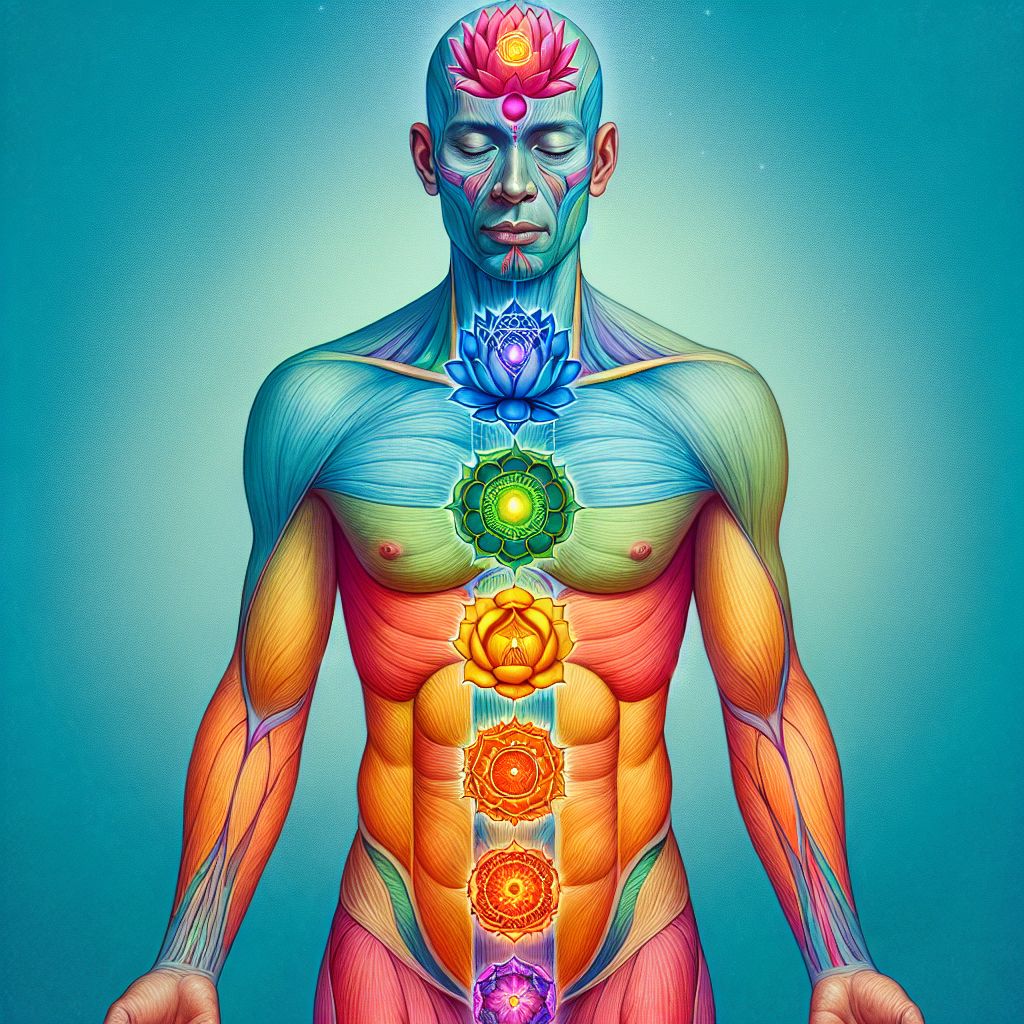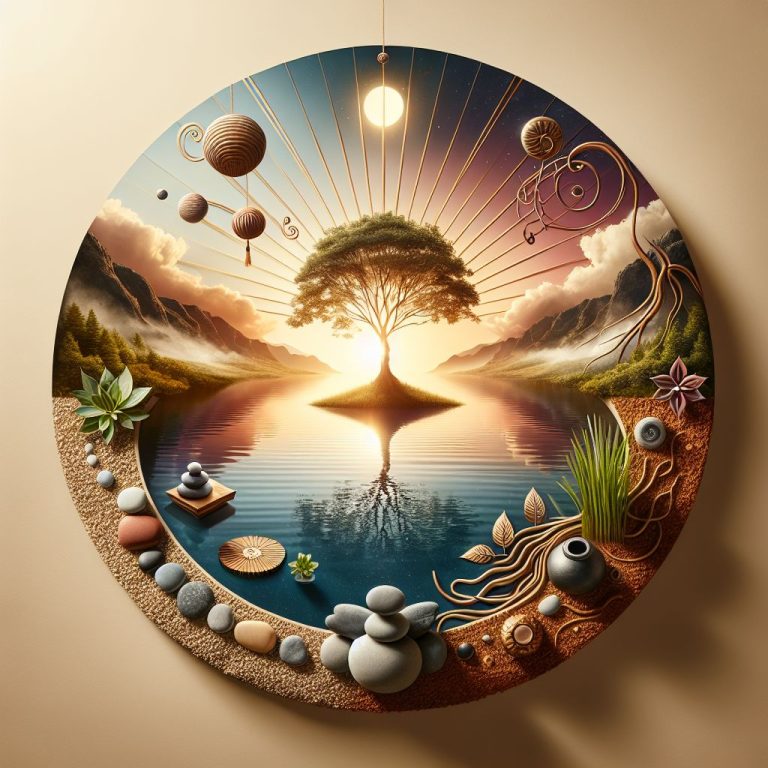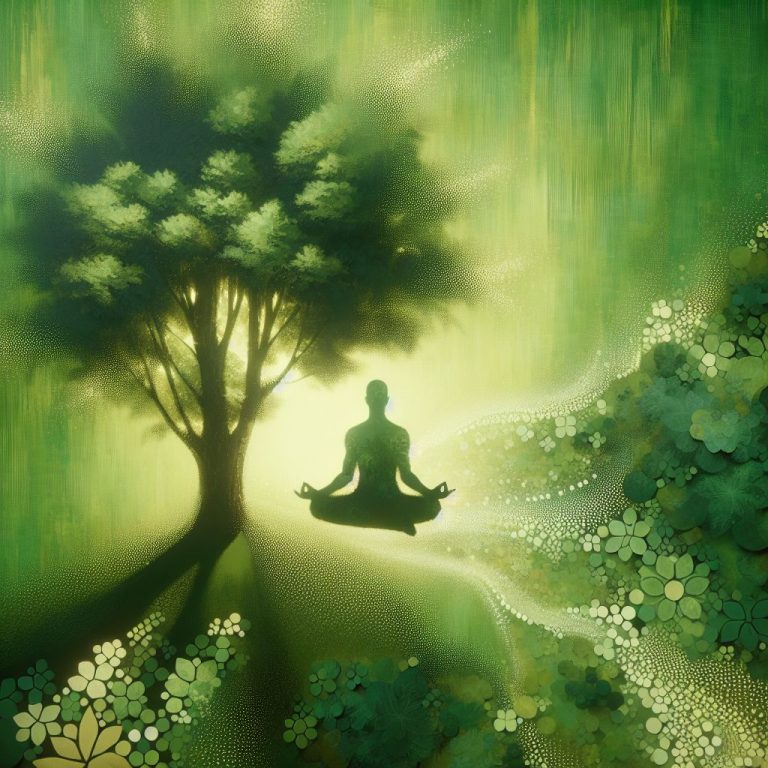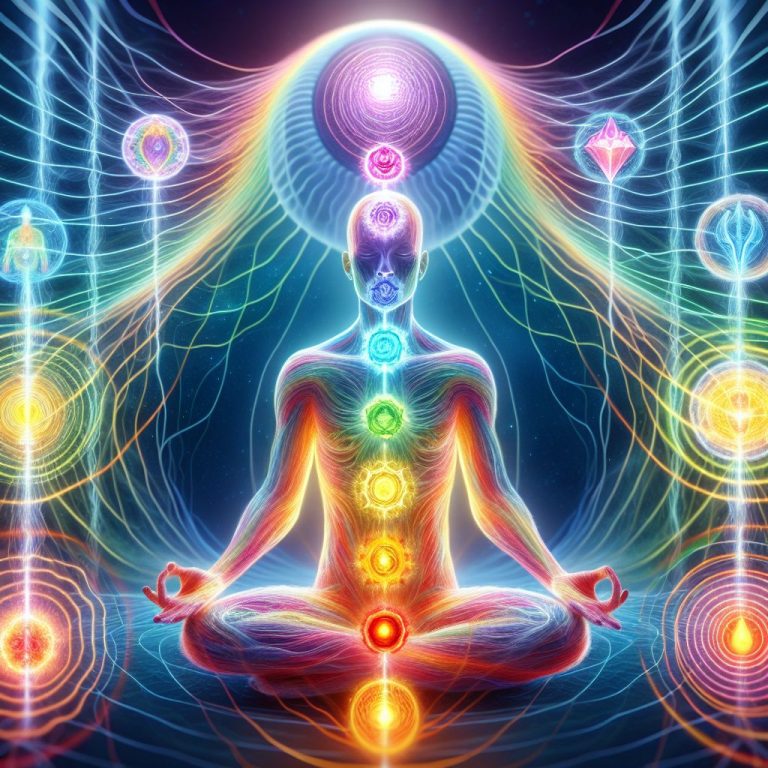What Are Chakras? A Complete Guide to Your Energy Centers

Key Takeaways
- Chakras are energy centers in the body, originating from ancient Indian philosophy.
- There are seven main chakras, each associated with different physical, emotional, and spiritual functions.
- Balanced chakras contribute to physical health, emotional stability, and spiritual growth.
- Signs of imbalanced chakras include physical ailments, emotional distress, and spiritual disconnect.
- Practices like meditation, yoga, and sound therapy can help balance and align chakras.
The Basics of Chakras: Your Body’s Energy Centers Explained
Imagine your body as a vast network of highways where energy flows continuously. The smooth flow of energy is essential for maintaining balance and harmony within your physical and spiritual self. Chakras, the energy centers in your body, are like the critical junctions on this network. When they function well, you experience health and peace. But if they get blocked, it’s like a traffic jam, leading to discomfort and disharmony.
Definition and Origin of Chakras
The term “chakra” comes from the ancient Sanskrit word meaning “wheel” or “disk.” It symbolizes the spinning vortex of energy within your body. The concept of chakras has its roots in ancient Indian traditions, particularly in Hinduism and Buddhism, where they are considered vital to one’s spiritual journey. These energy centers are not just mythical ideas but are central to many spiritual practices that aim to enhance well-being and consciousness.
The Seven Main Chakras
Let’s dive into the seven primary chakras, each with its unique attributes and responsibilities:
- Root Chakra (Muladhara): Located at the base of the spine, it represents grounding and stability.
- Sacral Chakra (Svadhisthana): Found in the lower abdomen, it governs creativity and sexual energy.
- Solar Plexus Chakra (Manipura): Situated in the upper abdomen, it controls personal power and confidence.
- Heart Chakra (Anahata): Centered in the chest, it is the source of love and compassion.
- Throat Chakra (Vishuddha): Located at the throat, it facilitates communication and self-expression.
- Third Eye Chakra (Ajna): Found between the eyebrows, it is linked to intuition and insight.
- Crown Chakra (Sahasrara): Situated at the top of the head, it connects you to higher consciousness.
Importance of Chakras in Spiritual and Physical Health
Why should you care about chakras? Well, they play a crucial role in your overall well-being. When your chakras are balanced, you feel vibrant, confident, and at peace. They help maintain the harmony between your body, mind, and spirit. However, when chakras are blocked or misaligned, it can lead to various physical, emotional, and spiritual issues. For example, an imbalanced root chakra might cause feelings of insecurity, while a blocked heart chakra could lead to difficulties in forming emotional connections.
Exploring the Seven Major Chakras
Now, let’s take a closer look at each chakra, starting with the Root Chakra. Understanding each energy center’s unique characteristics can help you identify areas in your life that might need attention.
The Root Chakra, or Muladhara, is your foundation. It connects you to the earth and provides a sense of security. When balanced, you feel grounded and stable. However, an imbalanced root chakra might manifest as anxiety or financial instability. To nurture this chakra, try spending time in nature, practicing grounding yoga poses, or using affirmations like “I am safe and secure.” For more insights, explore the energy shifts expected in 2025 and how they might impact your chakras.
Root Chakra (Muladhara)
The Root Chakra is your body’s anchor, connecting you to the earth’s energy. It is associated with the color red and is located at the base of the spine. This chakra influences your basic survival needs, such as food, shelter, and safety. When balanced, it fosters a sense of stability and confidence. But when it’s blocked, you might feel anxious or insecure.
To balance the Root Chakra, engage in grounding activities. Walking barefoot on grass, practicing deep breathing, or visualizing a strong red light at the base of your spine can help. Additionally, focusing on affirmations like “I am grounded and stable” can reinforce this chakra’s energy.
Sacral Chakra (Svadhisthana)
Next is the Sacral Chakra, located in the lower abdomen, just below the navel. It is the center of creativity, pleasure, and emotional expression. The color associated with this chakra is orange. When balanced, it allows you to enjoy life’s pleasures and embrace your creativity. However, an imbalanced sacral chakra can lead to emotional instability or a lack of creativity.
To harmonize the Sacral Chakra, indulge in creative activities like painting, dancing, or writing. Embrace your emotions without judgment and allow yourself to experience joy. You might also use affirmations such as “I am creative and joyful” to boost this chakra’s energy.
Solar Plexus Chakra (Manipura)
The Solar Plexus Chakra, or Manipura, is located in the upper abdomen. It is your power center, governing personal power, self-esteem, and confidence. Associated with the color yellow, this chakra is like your internal sun, radiating energy and strength. When balanced, you feel empowered and in control. But when it’s out of balance, you might struggle with low self-esteem or lack motivation. For a deeper understanding, explore this Complete Guide To The 7 Chakras.
To strengthen the Solar Plexus Chakra, engage in activities that boost your confidence. This could be setting and achieving small goals, practicing self-affirmations like “I am powerful and confident,” or engaging in core-strengthening exercises. Remember, this chakra thrives on your belief in yourself and your capabilities. For more insights on energy dynamics, check out energy shifts and how to prepare.
Crown Chakra (Sahasrara)
The Crown Chakra, or Sahasrara, is the pinnacle of your energy centers. Located at the very top of your head, it is associated with the color violet or white and represents your connection to the divine and the universe. This chakra is your gateway to higher consciousness and spiritual enlightenment. When balanced, you feel a sense of peace, purpose, and connection to all living things. However, an imbalanced Crown Chakra can lead to feelings of disconnection, cynicism, or a lack of direction in life.
To balance the Crown Chakra, engage in meditation practices that focus on spiritual growth and connection. Spending time in quiet reflection, practicing gratitude, and connecting with nature can also help. Affirmations such as “I am connected to the divine source” can strengthen your spiritual connection and open your mind to higher wisdom.
Signs of Imbalance in Chakras
Understanding the signs of chakra imbalances is crucial for maintaining your overall well-being. When one or more chakras are out of alignment, it can manifest as physical, emotional, or spiritual disturbances. Recognizing these signs can help you take proactive steps to restore balance and harmony within your body and mind.
Physical Symptoms
Each chakra corresponds to specific physical areas and functions of the body. When a chakra is blocked or imbalanced, it can lead to physical symptoms. For example, an imbalanced Root Chakra might cause issues with your legs, feet, or lower back. Similarly, a blocked Throat Chakra can result in throat or thyroid problems.
|
Chakra |
Physical Symptoms |
|---|---|
|
Root Chakra |
Leg pain, lower back issues |
|
Sacral Chakra |
Reproductive issues, lower abdominal pain |
|
Solar Plexus Chakra |
Digestive problems, fatigue |
|
Heart Chakra |
Heart or lung issues, upper back pain |
|
Throat Chakra |
Sore throat, thyroid problems |
|
Third Eye Chakra |
Headaches, vision problems |
|
Crown Chakra |
Neurological disorders, insomnia |
It’s important to listen to your body and notice any recurring physical issues. These symptoms can be signals that one or more of your chakras need attention.
Emotional Indications
Chakra imbalances can also manifest as emotional disturbances. Each chakra governs different emotional aspects, and an imbalance can lead to specific emotional challenges.
- Root Chakra: Anxiety, insecurity
- Sacral Chakra: Lack of creativity, emotional instability
- Solar Plexus Chakra: Low self-esteem, lack of motivation
- Heart Chakra: Difficulty in forming relationships, lack of empathy
- Throat Chakra: Fear of speaking, inability to express oneself
- Third Eye Chakra: Lack of intuition, confusion
- Crown Chakra: Feeling disconnected, lack of purpose
Pay attention to your emotions and how they affect your daily life. If you notice persistent emotional challenges, it might be time to explore chakra balancing techniques.
Spiritual Disturbances
Beyond physical and emotional symptoms, chakra imbalances can also lead to spiritual disturbances. When your chakras are misaligned, you may feel a disconnect from your spiritual path or a lack of clarity in your life’s purpose. To better understand these shifts, you might want to explore energy shifts and how they can impact your spiritual journey.
For instance, a blocked Third Eye Chakra can cloud your intuition and make it difficult to trust your inner guidance. Similarly, an imbalanced Crown Chakra might leave you feeling isolated from the divine or questioning your place in the universe.
Recognizing these spiritual disturbances is the first step towards healing and realignment. By addressing the underlying chakra imbalances, you can restore your spiritual connection and find greater meaning in your life.
Methods to Balance and Align Chakras
Balancing your chakras is a journey towards self-discovery and healing. There are various methods you can use to realign your energy centers and restore harmony within your body and mind. Let’s explore some effective techniques for chakra balancing.
- Meditation Practices
- Yoga and Chakras
- Use of Crystals and Essential Oils
- Mantras and Sound Therapy
- Massage
Meditation Practices
Meditation is a powerful tool for balancing chakras. By focusing your mind and energy, you can clear blockages and promote the free flow of energy throughout your body. Try practicing chakra-specific meditations, where you visualize each chakra as a spinning wheel of light, clearing any obstructions and radiating vibrant energy.
Incorporating breathwork into your meditation can also enhance the balancing process. Deep, rhythmic breathing helps calm the mind and body, allowing you to connect with your inner self and facilitate healing.
Yoga and Chakras
Yoga is another effective method for balancing chakras. Specific yoga poses target different chakras, helping to release tension and promote energy flow. For example, grounding poses like Tree Pose or Mountain Pose can help balance the Root Chakra, while heart-opening poses like Camel Pose can activate the Heart Chakra.
Regular yoga practice not only supports physical flexibility and strength but also enhances your overall energy balance. By aligning your body and breath, you create a harmonious environment for your chakras to thrive.
Improved Emotional Well-being
Balanced chakras contribute significantly to emotional well-being. When your energy centers are aligned, you experience greater emotional stability and resilience. This balance helps you navigate life’s challenges with a calm and centered approach, reducing stress and anxiety.
For instance, a balanced Heart Chakra allows you to form deep, meaningful connections with others, fostering empathy and compassion. Similarly, a harmonious Sacral Chakra enables you to express your emotions freely and embrace joy in everyday life.
Deepened Spiritual Awareness
As you align your chakras, you also enhance your spiritual awareness. Balanced chakras create a clear channel for spiritual energy to flow, connecting you to higher consciousness and divine wisdom. This heightened awareness allows you to tap into your intuition and trust your inner guidance.
Moreover, a balanced Crown Chakra facilitates a profound connection to the universe, helping you understand your purpose and place in the world. By nurturing your spiritual awareness, you cultivate a deeper sense of peace and fulfillment.
Incorporating Chakra Practice into Daily Life
Integrating chakra balancing into your daily routine doesn’t have to be complicated. With simple practices and a commitment to self-care, you can maintain balanced energy centers and enjoy the benefits of a harmonious life.
Here are some practical ways to incorporate chakra practice into your everyday life:
Simple Daily Routines
Start by dedicating a few minutes each day to chakra-focused meditation or yoga. Laying down, place your hands gently on each chakra point. Focus on breathing vitality and breathing out stress, once you feel the tension begin to roll away move onto the next chakra point. Even a short session can make a significant difference in maintaining your energy balance. Focus on deep breathing and visualization to clear blockages and enhance energy flow.
Creating a Personal Chakra Space
Designate a space in your home for chakra practice. This could be a corner of a room or a dedicated meditation area. Fill it with items that resonate with your energy, such as crystals, candles, or calming music. Having a personal space encourages consistency in your practice.
Consider using essential oils or incense to create a soothing atmosphere. Scents like lavender, sandalwood, or frankincense can enhance your meditation and help you connect with your chakras on a deeper level. For insights on upcoming energy shifts, you might find it helpful to explore how these practices align with future changes.
- Use crystals like amethyst for the Crown Chakra or rose quartz for the Heart Chakra.
- Play calming music or sound therapy tracks that resonate with specific chakras.
- Incorporate visual aids like chakra charts or artwork to focus your energy.
Consistency and Commitment to Practice
Consistency is key when it comes to chakra balancing. Make it a habit to check in with your energy centers regularly and address any imbalances as they arise. Remember, the journey to balanced chakras is ongoing and requires dedication.
Frequently Asked Questions (FAQ)
To further assist you on your chakra journey, here are some common questions and answers about chakra balancing:
How do I know if my chakras are blocked?
Pay attention to physical, emotional, and spiritual signs. Persistent issues in these areas can indicate blocked chakras. Regular self-assessment and awareness of your body’s signals are crucial for identifying imbalances.
Can anyone practice chakra balancing?
Absolutely! Chakra balancing is accessible to everyone, regardless of age or experience level. Start with simple practices and gradually explore more advanced techniques as you become comfortable.
Remember, the key is to approach chakra balancing with an open mind and a willingness to learn. Your unique journey will unfold as you deepen your understanding of energy shifts.
Are there more than seven chakras?
While the seven main chakras are the most commonly discussed, some traditions acknowledge additional chakras beyond these primary ones. These minor chakras are often seen as secondary energy points that support the main chakras.
However, focusing on the seven primary chakras provides a solid foundation for understanding and balancing your energy system. As you progress in your practice, you may choose to explore these additional chakras.
For now, concentrate on the seven main chakras to build a strong energetic foundation. To further understand the shifts in energy, you might find it helpful to explore upcoming energy shifts in 2025 and how to prepare for them.
- Root Chakra
- Sacral Chakra
- Solar Plexus Chakra
- Heart Chakra
- Throat Chakra
- Third Eye Chakra
- Crown Chakra
Do I need special tools to balance my chakras?
While tools like crystals, essential oils, and sound therapy can enhance your practice, they are not necessary for chakra balancing. The most important tools are your intention and focus.
Start with simple practices like meditation and visualization, and incorporate additional tools as you feel drawn to them. Your intuition will guide you to the resources that resonate with your energy.
Remember, the power of chakra balancing lies within you. Trust your instincts and explore the techniques that work best for you.
How often should I perform chakra balancing exercises?
Regular practice is essential for maintaining balanced chakras. Aim to incorporate chakra exercises into your routine at least a few times a week. Consistency will help you achieve lasting results. To better prepare for upcoming energy shifts, consider making chakra balancing a part of your regular wellness practice.
Listen to your body and adjust your practice as needed. Some days you may feel the need for more intensive balancing, while other days a brief meditation will suffice. Trust your intuition to guide your practice.
In conclusion, understanding and balancing your chakras is a transformative journey that can enhance your physical, emotional, and spiritual well-being. By incorporating simple practices into your daily life, you can maintain harmonious energy centers and enjoy a more balanced, fulfilling life.






